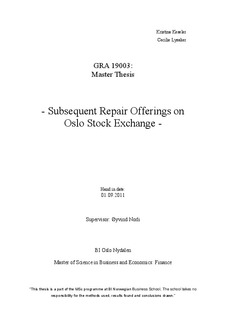Subsequent repair offerings on Oslo stock exchange
Abstract
This master thesis aims to investigate why subsequent repair issues are performed. Using data from the Oslo Stock Exchange from 1997 to 2009, we will take a look at whether the following factors are possible explanations for choosing this type of floatation method: 1) The announcement effect 2) The discount of the private placement and 3) The size of the private placement as a percentage of the company’s market value. Through an event study we found the announcement effect of both the pure private placements, 0.70%, and the private placements with subsequent repair issues, 2.96%. By including the subsequent repair issues we find a larger effect, indicating a possible financial reason for adding a repair offering. However, only the announcement effect of the pure private placement was found to be significant. Secondly, we find considerable differences between the average discount of a pure private placement, 5.81%, and a private placement with a repair issue, 17.92%. This suggests that subsequent repair offerings are chosen when discounts are high, putting weight on equal treatment of the excluded shareholders. Additionally, we established that the average size of a pure private placement, 19.16 %, is substantially lower than that of a private placement with a repair issue, 61.36 %. This also supports equal treatment of the shareholders, seeing as larger private placements result in larger dilution of the shares.
Description
Masteroppgave(MSc) in Master of Science in Business, Finance - Handelshøyskolen BI, 2012
